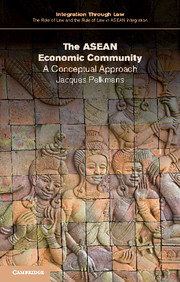Book contents
- Frontmatter
- Contents
- List of figures
- List of tables
- List of boxes
- General editors’ preface
- 1 Introduction and purpose
- 2 Foundations of economic integration fundamentals, stages and credibility
- 3 Conceptual foundation of the ASEAN Economic Community
- 4 Implementation of the AEC: progress in adopting instruments from the Roadmap
- 5 A reality check: comparing the AEC and NAFTA on substance
- 6 Options for the AEC and their practical implications
- 7 Conclusions
- Executive summary
- Appendix 1
- References
- Index
3 - Conceptual foundation of the ASEAN Economic Community
Published online by Cambridge University Press: 05 March 2016
- Frontmatter
- Contents
- List of figures
- List of tables
- List of boxes
- General editors’ preface
- 1 Introduction and purpose
- 2 Foundations of economic integration fundamentals, stages and credibility
- 3 Conceptual foundation of the ASEAN Economic Community
- 4 Implementation of the AEC: progress in adopting instruments from the Roadmap
- 5 A reality check: comparing the AEC and NAFTA on substance
- 6 Options for the AEC and their practical implications
- 7 Conclusions
- Executive summary
- Appendix 1
- References
- Index
Summary
This section forms an attempt to identify and understand what the AEC actually is. Once again, conceptually. Section 3.1 recalls the Bali Concord II declaration, and section 3.2 the substantive ingredients of the HLTF's recommendations. Section 3.3 attempts to grasp the contents and economic meaning of the Bali ‘vision’ on the basis of a series of conceptual queries. Section 3.4 summarises the Roadmap for the AEC as published in 2010 in a stylised fashion, with annotations and queries where appropriate as well as a cursory assessment of progress to date, fitting the conceptual analysis.
The AEC ‘vision’ declared in Bali
ASEAN is well known for its capacity to deliver elegantly drafted declarations. The Bali Declaration is no exception. If one is willing, one can read a lot in the declaration. In any event, a closer reading demonstrates that Bali amounted to a breakthrough, the more so as it was accompanied by the HLTF recommendations, as an early attempt to flesh out the ‘vision’ in more operational terms. Figure 3.1 stylises the declaration itself.
Figure 3.1 starts with the cardinal announcement that ASEAN wants deeper, but not ‘open-ended’, economic integration (as the EU, for example). As we shall elaborate in Chapters 4 and 5, this makes the substance of the AEC comparable to that of NAFTA. The overall rationale for the AEC is said to be a ‘stable, prosperous and highly competitive ASEAN economic region’, an ambitious aim. The third box quotes four aspects (literally), but the first two are ‘means’ (free flows, or freer flow) and the other two are aspirations. The two ‘means’ specified might be instrumental for the two aspirations, but this is not a priori the case. It might require both national- and ASEAN-level means to ensure this (especially with respect to socio-economic disparities). The declaration mentions ‘technical and development cooperation’. So far, intra-ASEAN cooperation in this field has been weak at best, complemented by foreign projects. However, in the cooperation box (right-hand side), one of the nine areas for cooperation is ‘human resources development and capacity building’. There is no reference to its funding.
A further specification is found in the upper-left box, namely, a ‘single market’ (an extremely ambitious concept) and ‘production base’; business complementation better connecting ASEAN to global value chains (or, perhaps, the other way around) and enhancing ASEAN's economic competitiveness.
- Type
- Chapter
- Information
- The ASEAN Economic CommunityA Conceptual Approach, pp. 75 - 115Publisher: Cambridge University PressPrint publication year: 2016

